Let forensic science help prevent a crime or a disaster

One of the basic principles of forensic science is Locard's Exchange Principle which says: "Every contact leaves a trace." It was formulated in the early 20th century, by French criminologist Edmond Locard, and still informs forensic inquiries today.
But the term "trace" is no longer explicit to physical and biological traces. It also includes digital ones where cyber or virtual contacts (emailing, Skyping, surfing the net, and so on) leave digital imprints such as an IP address or the International Mobile Equipment Identity (IMEI) of a mobile phone.
The work of forensic scientists has so far been overwhelmed with identifying, collecting and analysing such traces to see if they map to a suspect in a specific investigation.
But hardly any time, resources or support are used to try to detect certain patterns across those traces. Forensic scientists worldwide are not encouraged or even allowed to be proactive; rather, they are simply reactive.
The main reason behind the lack of support and shortage in funding for forensic scientists is that the relationship between law enforcement and forensics is more of control and dominance rather than true partnership.
In other words, the vast majority of law enforcement agencies worldwide still control forensic science practice, set their priorities and set the budget for things such as research and training.
Evidence from the past
But forensic scientists have in the past done much to identify patterns that have led to changes in behaviour.
It was forensic medical practitioners who identified that placing babies face down to sleep was one of the contributors to sudden infant death syndrome (SIDS).
Following awareness campaigns such as the worldwide Back to Sleep campaign in the early 1990s, SIDS has declined from 2 to 0.5 per 1,000 live births in many developed countries in 2007. In England and Wales it has dropped to 0.28 per 1,000 live births.
Other examples on the preventive role of forensics can be extracted from transportation safety regulations, where the investigation carried out by forensic experts led to improvements such as seatbelts and avoiding texting while driving.
Evidence from the present
The notion of protective and preventive forensic science was reflected in the recent International Academy of Legal Medicine conference that I participated in, held in Venice in June.
The conference's theme was P5: Medicine and Justice. The P5 symbolises the five Ps: personalised, preventive, predictive, participatory and protection. These five Ps support the proactive notion of forensic science and forensic medicine.
But much is still needed. For instance, the conference was told that forensic medical practitioners in a number of countries report instances of domestic and sexual violence against foreign housekeepers. They have detected certain patterns in the assessment of these cases and are keen to combat this issue, but to no avail.
Law enforcement and authorities are mainly interested in the forensic work and autopsy if required.
Another example is forensic medical practitioners who are called to investigate incidents relating to refugees and displaced people in camps. They told the conference that in some incidents, death was not a result of a criminal behaviour but due to negligence and lack of safety measures.
These practitioners are very keen to work on awareness campaigns to minimise and reduce these incidents. These practitioners are the ones on the frontline and they are the best situated to recommend to authorities the Dos and Don'ts.
But no one is really interested to listen beyond their forensic report and testimony in a court of law.
Lessons for the future
We now live in a world faced with more security challenges, terrorist attacks, repeated security breaches in what we once assumed were secure places such as airports.
There is increasing ambiguity surrounding incidents, for example aeroplane crashes and mobile phones exploding while charging, so a shift from the reactive to proactive mode is required.
Imagine if forensic scientists who examined the personal items collected from a terrorist could further investigate such items – and those of other terrorists – so they could detect certain patterns. This could help prevent the occurrence of further attacks.
Imagine if forensic scientists investigating a suspected death of a child wandering with a digital device were able to build a hypothesis relating to the device. They could then consult with engineers to further research the matter and come up with extra measures for product safety.
Imagine if similar patterns were identified for workplace-related injuries. Imagine how safer and securer it would be.
The current quasi-military and legal mindset needs to change and support forensic scientists to go beyond the standard work on traces. They need to be encouraged to investigate patterns or potential patterns across these traces.
Such inquiries will prompt collaborative work with criminologists, engineers, social psychologists, educators, police, intelligence departments and policymakers. The aim of all would be to find out how to prevent the occurrence or minimise the recurrence of an incident, crime or attack.
It is about time forensic scientists are listened to and that the science and scientific mindset lead the work.
It is about time that scientific curiosity for pattern identification leads proactive conversations across various fields and disciplines to ensure safety, security, protection, prevention and justice.
Conventionally, forensic science and forensic medicine have been perceived as sciences associated with crimes, deaths, disasters, disputes and offences. It is about time that forensics is seen as a science for life and for cherishing life.
Source: The Conversation
This article was originally published on The Conversation. Read the original article.
![]()

















